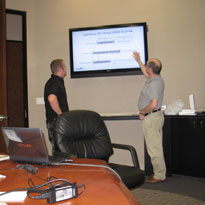Antennas
- Course:Antennas
- Course ID:ANTENNA Duration:1-3 days Where: Your Office (7+ Persons)
- Download Course Description (PDF)
Available as a private, customized course for your group at your offices or ours and in some cases as a WebLive(TM) class.
Course Outline
- Radio Spectrum and the Radio Frequency (RF) Transmission Basics
- Basic RF definitions
- Frequency and wavelength relationships
- Propagation: E and H fields
- Antenna polarization: Horizontal, vertical and circular
- The radio spectrum
- ITU band designations
- IEEE military bands
- Multipath and fading in a mobile environment
- Constructive and destructive interference
- Scattering and ducting
- Frequency selective fading
- Multipath radio signals
- Rayleigh fading and multipath reception
- How to handle multipath fading
- Path loss calculations
- Summary of important RF concepts
- Antenna Design and Performance Issues
- Functional purpose of an antenna
- Antenna characteristics and terminology
- The reference isotropic antenna
- Gain and directivity calculations
- The capture effect
- Antenna patterns
- Beamwidth
- Aperture
- Side lobe definition
- Front-to-back ratio
- Satellite antenna polarization: Linear and circular
- Antenna Arrays for the HF Bands
- Horizontal dipole
- Broadband dipole
- Rhombic antenna
- Inverted V
- Fixed horizontal and vertical log-periodic
- Rotatable log periodic
- Rotatable curtain array
- Inverted L
- Broadband monopole
- UHF Band Antennas
- Yagi
- Log-periodic
- Cellular system antenna considerations
- 800 MHz and 1900 MHz antenna design considerations
- Receive diversity and diversity combining
- Antenna physical features and tower mounting
- Cellular sectorized antenna configurations
- Antenna tilt and cell coverage patterns
- Transmit and receive diversity antennas
- Monopole and collinear optional design features
- Smart phased-array antennas: Switched beam and adaptive array
- MIMO
- DOA estimation
- Cell tower classifications
- Lattice
- Monopole
- Guyed
- Stealth
- WiMAX and WiFi access point antenna options
- Microwave and Radar Antennas
- Parabolic dish
- Horns
- Fan-Beam
- Cosecant squared pattern
- Stacked-beam cosecant squared pattern
- Cassegrain antenna
- Phased-array antennas
- Phased array feed systems: Active and passive
- Phase shifter theory
- Wrap-up: Course Review, Q/A, and Evaluations
Course in a Nutshell
From base stations to mobiles and microwave dishes to radars, antennas are a pervasive and important element of all RF systems. What are the features that characterize an antenna, whether transmitting or receiving? How does the system performance depend on these antenna characteristics? How should one select, configure, and mount an antenna to effectively serve current needs as well as future demands? How are the evolving (e.g., 4G wireless and beyond) radio technologies influencing and are being influenced by the ever increasing complexity and sophistication of antennas? These and other questions are the subject of this important course. The answers will help you exploit antennas more effectively, whether you’re designing a new network, optimizing an existing one, or migrating it to a new technology.
Customize It!
Customize this course at little-to-no additional cost to your specific needs. You may tailor it to type of radio system you work with, whether 3G or 4G+ wireless/cellular, WiFI, WiMAX, HF/UHF, microwave, radar, or military. You may also adapt it to your intended audience, e.g., network design and optimization engineers, equipment or application designers, equipment installers, and less technical audiences such as in deployment, sales and marketing, and operations and support.
For an integrated treatment of RF propagation and antennas, combine this course with RF Propagation Models, Fading Characteristics, and Link Budget (RFPROP, 3 days).
Aimed At
Engineers and technicians responsible for the design, selection, integration, or deployment of antennas.
Prerequisites
At least one year experience in the field of communication engineering, fixed or wireless telephony, or related technical fields.

